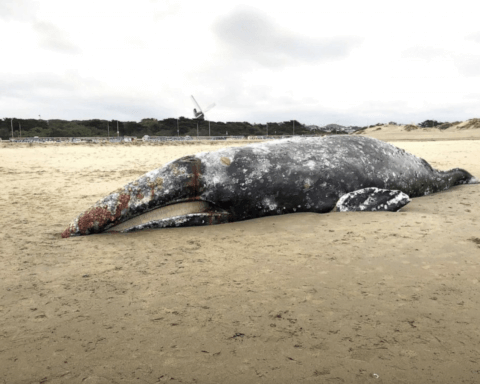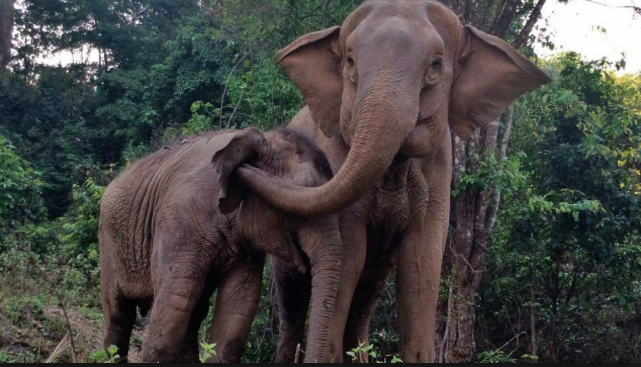*The world’s remaining ancient forests are breathtaking “flying rivers.” They move water on almost inconceivably large scales. The ancient forests are also vital medicine chests for the bees.
The oceans are the main drivers of climate, yet new information reveals just how critical ancient forests are at creating climate and influencing it across a continent and around the globe. When ancient forests are razed, all hell breaks loose halfway around the world.

Once upon a time, it was believed that it’s wet therefore there are forests. Today, we know the opposite; there are forests, therefore it’s wet. For example, the Amazon rainforest discharges 20 trillion liters of moisture daily – roughly 17 percent more water flow than even the mighty Amazon River, the largest river on Earth. Awesome.
The health of ancient forests depends upon both big and small inhabitants. In the U.S. Pacific Northwest, the colossal Douglas-firs, salmon and bears along with birch and willow trees are inexorably linked to specialized fungi, particularly red-belted polypore mushrooms like reishi and amadou.

Fungi play a crucial role in breaking down wood (cellulose, hemicellulose and especially lignin, Nature’s wood glue). Bears use trees as both communicating and scratching posts. In so doing, they inadvertently remove patches of bark enabling fungal spores, or, seeds, to get access to open tree wounds and gain new real estate to grow mushrooms, the fruiting body of fungi.
Fungal roots are known as mycelium. They occupy forest soils in vast numbers and they create soil.
Soil is life.
Bees pollinate 75 percent of Man’s food crops. Each year, honeybees produce 2.2 billion pounds of honey and 44 million pounds of beeswax.”
Renowned mycologist, or fungi expert, Paul Stamets says, “Amadou and reishi mushrooms are like pharmaceutical factories.”

About 30 years ago, Stamets noticed honey bees in his garden, moving wood chips for 40 consecutive days, in order to access and harvest droplets that were actively secreted by the mycelium. Extracellular mycelium droplets are loaded with acids, enzymes, messenger molecules and rich with sugars.
Stamets spends his time wisely, walking and observing the ancient forests, which he affectionately calls “his Sunday church.” He’s an accomplished lifelong student of Nature, constantly assimilating knowledge and probing for new discoveries.

When he first saw the bees feeding from the mycelium, Stamets surmised they were seeking polysaccharides, a mixture of sugar molecules, to dehydrate into honey. Honey is the worker bee’s only food source.
Fast forward to 2014. Stamets had a vision in a lucid dream that the bees were not only feeding from the mycelium droplets, but also attaining potent medicines.

One of the more powerful constituents of honey is a polyphenol, or, plant defense mechanism, called p-coumaric acid. P-coumaric acid controls detoxification pathways in bees, Man and other animals, too.
It turns out that the bees depend upon the mycelium droplets to turn on almost four dozen or so genes for p-coumaric acid to perform detoxification. In turn, the fungi depend upon decomposing wood in the ancient forests to draw its energy and sustain the glorious web of life.

If there’s no decomposing wood, there are no fungi. The bees detoxification system is shut off. They hyper-accumulate man-made toxins from fungicides, herbicides, insecticides and miticides. Bee populations crash.
Stamets and his collaborator from Washington State University, professor Walter Sheppard, have applied this exquisite information to revitalize U.S. honeybees.
In 2017-2018, the annual honeybee loss from commercial hives was very high at 40.1 percent. It’s a crisis. Man-made poisons, i.e. neonicotinoids, malnutrition, habitat loss, the climate crisis, introduced pathogens and parasites, e.g. varroa mites have all collided.
Bees pollinate 75 percent of Man’s food crops. Each year, honeybees produce 2.2 billion pounds of honey and 44 million pounds of beeswax. Bee glue, or, propolis, is an effective antidote for oral herpes and prostate cancer. Globally, the bees generate $577 billion in annual commerce.
Stamets and his collaborators discovered when bees collected mycelium droplets, dehydrated them and added bee enzymes to make mycohoney, or, mushroom honey, that it boosted their autoimmune systems, which extended their lifespan.

Recently, Stamets research team discovered that amadou mycelium extract conferred incredible strength to fend off the Deformed Wing virus carried by the blood sucking varroa mites. (An 800-fold decrease in the laboratory). Bees fed reishi mycelium extract saw a remarkable 45,000-fold reduction in Lake Sinai virus, another hideous disease ravaging honeybee populations.
Stamets company, Fungi Perfecti, will soon be selling mycohoney and mycelium extract so that beekeepers across America and elsewhere have Nature’s medicine to keep their hives healthy.

From giant trees to diminutive medicinal mycelium, these oxygen breathing, water creating ancient masterpieces are stunning. Protecting all the remaining ancient forests from chainsaws and poachers is not only the key to saving the bees, but it is also the key to our survival. Hallelujah!
#FightForThePlanet
#Resist
•••••••••••••••••••••••••••••••••••••••••••••
Dr Reese Halter is an award-winning broadcaster, distinguished conservation biologist and author.
Dr Reese Halter’s latest book is
Love! Nature
Tweet @RelentlessReese
•••••••••••••••••••••••••••••••••••••••••••••












